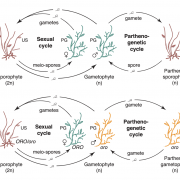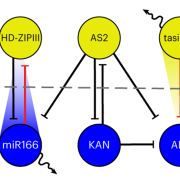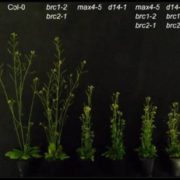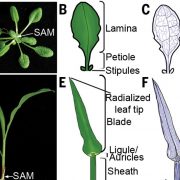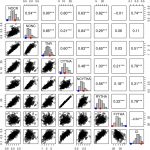Molecular regulation of meristem development in liverworts (Curr. Biol.)
 Plants grow through meristems, pools of undifferentiated cells that produce and develop into all varieties of cell types. Flowering plants such as Arabidopsis regulate meristematic cell division through CLAVATA3/EMBRYOSURROUNDING REGION-related (CLE) peptide signaling, but the molecular mechanisms in which this regulation is performed in land plant ancestors have yet to be fully uncovered. Hirakawa et al. further deciphered these mechanisms in the liverwort Marchantia polymorpha. Relative to flowering plants, the M. polymorpha genome contains a minimal set of CLE genes, and the function of MpCLE2, the sole orthologue of CLAVATA3, has been unknown. The authors revealed that enhanced MpCLE2 peptide signaling induced larger apical notches and an increased number of meristematic regions, which led to multichotomous branching and dwarfed, convoluted thalli. Further experiments, using genetics and marker lines, demonstrate that signaling between MpCLE2 and MpCLV1 (a receptor protein for the MpCLE2 peptide) “acts as a positive regulator of stem cell maintenance in shoot meristems of the M. polymorpha gametophyte body.” Moreover, this signaling is independent of established downstream CLE targets in flowering plants. Such work opens the door for discovering how plants regulate the growth and development of their meristems, a vital pathway that allowed plants to colonize land. (Summary by Benjamin Jin) Curr. Biol. 10.1016/j.cub.2020.07.016
Plants grow through meristems, pools of undifferentiated cells that produce and develop into all varieties of cell types. Flowering plants such as Arabidopsis regulate meristematic cell division through CLAVATA3/EMBRYOSURROUNDING REGION-related (CLE) peptide signaling, but the molecular mechanisms in which this regulation is performed in land plant ancestors have yet to be fully uncovered. Hirakawa et al. further deciphered these mechanisms in the liverwort Marchantia polymorpha. Relative to flowering plants, the M. polymorpha genome contains a minimal set of CLE genes, and the function of MpCLE2, the sole orthologue of CLAVATA3, has been unknown. The authors revealed that enhanced MpCLE2 peptide signaling induced larger apical notches and an increased number of meristematic regions, which led to multichotomous branching and dwarfed, convoluted thalli. Further experiments, using genetics and marker lines, demonstrate that signaling between MpCLE2 and MpCLV1 (a receptor protein for the MpCLE2 peptide) “acts as a positive regulator of stem cell maintenance in shoot meristems of the M. polymorpha gametophyte body.” Moreover, this signaling is independent of established downstream CLE targets in flowering plants. Such work opens the door for discovering how plants regulate the growth and development of their meristems, a vital pathway that allowed plants to colonize land. (Summary by Benjamin Jin) Curr. Biol. 10.1016/j.cub.2020.07.016


